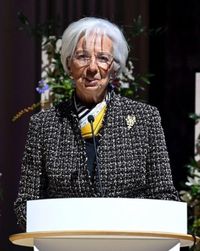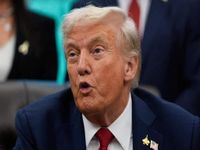Europe’s economic resilience has been put to the test in recent months as the continent grapples with a major shakeup in global trade policy. The catalyst? U.S. President Donald Trump’s imposition of sweeping new tariffs on European goods—a move that many feared would spell disaster for growth, inflation, and the delicate web of international commerce. Yet, against expectations, the eurozone economy is weathering the storm better than many predicted, and the world’s trade map is shifting in remarkable ways.
On September 30, 2025, European Central Bank President Christine Lagarde addressed a central banking conference in Helsinki, offering a surprisingly upbeat assessment of Europe’s fortunes. "A year ago, most would have assumed that U.S. tariffs... would trigger a major adverse shock to the euro area economy," she told the audience. "Yet some of these assumptions have not been borne out." According to the Associated Press, Lagarde credited this unexpected resilience to the European Union’s decision not to retaliate with its own tariffs—a move that could have set off a damaging cycle of tit-for-tat escalation.
Instead, the EU took a measured approach. The bloc’s executive commission had prepared a list of goods for possible retaliatory tariffs, but suspended those plans once a deal was struck between Trump and European Commission President Ursula von der Leyen in July. This agreement capped tariffs at 15%, removing a cloud of uncertainty that had threatened to stall business investment across the continent. As Lagarde explained, “There had been little impact on inflation, and effects on growth have been relatively moderate due to European governments taking pro-growth measures in response.”
Those measures have included a flurry of new trade agreements, not just with the United States but with partners around the world. According to The Economic Times, the EU has inked deals with the Mercosur bloc (Argentina, Brazil, Bolivia, Paraguay, and Uruguay), Mexico, and the European Free Trade Area. India and New Zealand have revived trade talks after a decade-long pause, while the United Arab Emirates signed three trade agreements in a single day this past January. These moves are part of a broader strategy to diversify trade and offset the effects of American protectionism, as well as Chinese export restrictions on critical minerals needed for Europe’s green transition.
EU trade chief Maros Sefcovic summed up the new reality in a recent debate: “The United States, which represented 17% of EU trade last year, was not the only game in town. We also need to take care of the other 83%. That means continuing our efforts to diversify our relations.” This sentiment has been welcomed by World Trade Organization Director-General Ngozi Okonjo-Iweala, who noted that such agreements “help to diversify trade, it supports the WTO. It's not in competition because most of these agreements are built on our platform.”
But are these new alliances enough to offset the pain of U.S. tariffs? The short answer is: not entirely, at least in the near term. Analysts at the Bruegel think tank estimate that the Trump tariffs could reduce EU GDP by 0.2-0.3%, while uncertainty may have a more pronounced effect on corporate investment. Sander Tordoir, chief economist at the Centre for European Reform, emphasized that Europe and its partners, such as Japan, run trade surpluses and thus need buyers, not more sellers. “The U.S. has long constituted about 50% of global trade deficits, acting as a key source of incremental demand for global exports,” he explained. In other words, finding new markets is one thing—creating enough demand to replace the American consumer is quite another.
To address this challenge, some economists argue that Europe must look inward and stoke its own internal demand, or risk stagnation. The EU’s recent investments in infrastructure and defense—especially in Germany, which has committed to large-scale spending on roads, rails, and bridges—are seen as steps in this direction. National governments have also ramped up defense budgets in response to security concerns from Russia, further boosting economic activity.
Meanwhile, the European Central Bank has kept its key interest rate steady at 2% since September 11, 2025, with the next policy meeting scheduled for October 30. Lagarde described the ECB’s current stance as “in a good place,” and signaled that the bank would not commit to any predetermined path of action or inaction. Inflation remains moderate, with the eurozone’s annual rate at 2% in August—helped in part by a strengthening euro, which has made imports cheaper and offset some of the upward pressure on prices caused by tariffs.
Supply chain disruptions, another major worry when the tariffs were first announced, have so far been minimal. “As a result, we have not yet seen significant supply chain disruption,” Lagarde told the conference. “Global supply chain pressures remain contained, and in the euro area, bottleneck indicators are close to historical averages.” This relative stability has allowed European businesses to continue accessing the raw materials and goods they need, without the bottlenecks and cost spikes that can so easily derail growth.
Still, the overall economic picture isn’t exactly rosy. Growth in the euro area was a modest 0.1% in the second quarter of 2025 compared to the previous quarter, and the combination of tariffs and uncertainty is expected to knock about 0.7 percentage points off growth through 2025 and 2027. In fact, GOBankingRates reports that the Penn Wharton Budget Model estimates tariffs could shrink U.S. GDP by about 6% and reduce wages by 5%, with similar—if less severe—effects likely in Europe.
Across the Atlantic, the U.S. faces its own set of challenges. Tariffs have generated more than $100 billion in revenue for the Treasury this year, but if the Supreme Court rules that the Trump administration overstepped its authority, the government could be forced to refund billions to businesses. Economists warn that such repayments could increase government borrowing and inflation, with little benefit to American consumers, who have already absorbed higher prices during the tariff period. “Tariffs are taxes that raise costs for Americans and slow economic growth,” Bryan Riley of the National Taxpayers Union explained. Even if businesses get refunds, ordinary Americans won’t see rebates for the extra they’ve paid.
As the world’s major economies race to forge new alliances and adapt to the shifting landscape, one thing is clear: the era of stable, predictable trade policy is over. The EU is positioning itself as a “reliable trading partner for the rest of the world,” in the words of Sabine Weyand, director-general of the EU executive’s trade division. But as new deals are struck and old certainties fade, the real test will be whether Europe—and the world—can generate enough growth from within to make up for a more fractious, protectionist global order.
For now, Europe’s ability to adapt, diversify, and avoid self-defeating retaliation seems to have spared it from the worst of the fallout. But with growth still sluggish and uncertainty lingering, the continent’s economic future remains anything but settled.





